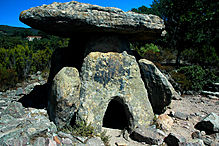|
|
|
|
Dolmen de Coste-RougeDolmen / Quoit / Cromlech
|
||||||||||||||||||
|
|
|
Images (click to view fullsize) |
|
Photographs:






 Artistic / Interpretive:
Artistic / Interpretive:

|
Fieldnotes |
|
|
Driving north and east of Lodeve up a very twisty-turny mountain lane we reached the Priory St Michel de Grandmont – our main attraction here is this fabulous dolmen in its private grounds. The entrance fee of E4.50 entitles you to look round the abbey (which has got a nice cloister and worth a peep) but you also get a guided tour to the dolmen. They don't let you go on your own we think because of the resident herd of fallow deer roaming free and they don't want hunters taking potshots and poaching. Despite having to drive such a long way to get here from our gite in Arles, having to pay an entrance fee and having to be escorted to the dolmen, it's all worth it because its FAB. A true Beauty. A capstone with exquisite flatness on its underside, such lovely stones leaning jauntily inwards are all surpassed by the charming catflap door in the portal stone. We had little time here (an elderly Belgian couple were escorted there at the same time as us) and so I immediately got to work drawing. It made me think about its picturesque loveliness of places like Poulabroune, combined with the startling wondrousness of the dolmens we'd seen on that hot Jordanian hillside two years before. This dolmen has been christianised - the monks at the abbey carved as small cross into one of the side stones. In the middle ages the dolmen was used in a bizarre way to cure leprosy. The monks would burn the clothes of the afflicted person, who would then climb up on the dolmen and twice roll around and rub their skin on the capstone. Such hocus pocus! Is it any wonder that I put my faith in science and not witchcraft? This post appears as part of the weblog entry Les dolmens Lodèvois
|
 Posted by Jane
Posted by Jane21st September 2007ce Edited 23rd September 2007ce |
|
Access: In grounds of St Michel de Grandmont Priory (Prieurié de St Michel-de-Grandmont). Smallish entrance charge for priory and dolmen together and only visitable with guide on a ten minute walk on undulating gravelly paths. Afterwards we realised that the guided tour allegedly also takes in a menhir (with interesting-sounding ruts and creases in the rock nearby) and 2 other (more battered) dolmens - the dolmens de Belvédère - but we weren't offered the option.... Take the A75 motorway to Lodève. We left it at junction 53 travelling north, then skirted the town on the D25, following signs to the priory onto the little D135 to the east. This is steep and winding to begin with as it climbs into the hills. Once onto the top of the hills, the priory is only a few km and still signposted. After our visit, we discovered that it's possible to spot the dolmen from one of the bends before you reach the priory. Visited Wednesday 5 September A stunner! We arrived at the priory at around 1pm and were told that the next planned tour to the dolmen was at 3pm, but that as it was quiet, the guide would take us and another couple in about 10 minutes. This was lucky as we didn't want to hang about, but possibly the reason we weren't shown the other dolmens and the menhir. I was too excited to remember they were even there, so we didn't think to ask about them. Gah. The dolmen was as thrilling as it looks. An impressive monument with a pretty unusual and well-preserved 'kennel-hole' entrance, a huge cuplike/ballaunlike depression on one side and a small carved 'christianising' cross on the other. The dolmen stands in low remnants of its rubble mound, on a ridge running out from the hillside. Beautiful views of surrounding hills and valleys, partially obscured by trees. The capstone is around 3.15 x 3 metres and rubbing against it was apparently a bizarre cure for skin diseases in the middle ages (according to Bruno Marc in Dolmens et Menhirs en Languedoc et Roussilion - if my French translation is good enough!) Wonderful! |
19th September 2007ce Edited 20th September 2007ce |

